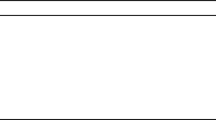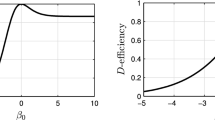Abstract
Experimental designs intended to match arbitrary target distributions are typically constructed via a variable transformation of a uniform experimental design. The inverse distribution function is one such transformation. The discrepancy is a measure of how well the empirical distribution of any design matches its target distribution. This chapter addresses the question of whether a variable transformation of a low discrepancy uniform design yields a low discrepancy design for the desired target distribution. The answer depends on the two kernel functions used to define the respective discrepancies. If these kernels satisfy certain conditions, then the answer is yes. However, these conditions may be undesirable for practical reasons. In such a case, the transformation of a low discrepancy uniform design may yield a design with a large discrepancy. We illustrate how this may occur. We also suggest some remedies. One remedy is to ensure that the original uniform design has optimal one-dimensional projections, but this remedy works best if the design is dense, or in other words, the ratio of sample size divided by the dimension of the random variable is relatively large. Another remedy is to use the transformed design as the input to a coordinate-exchange algorithm that optimizes the desired discrepancy, and this works for both dense or sparse designs. The effectiveness of these two remedies is illustrated via simulation.
Access this chapter
Tax calculation will be finalised at checkout
Purchases are for personal use only
Similar content being viewed by others
References
Aronszajn, N.: Theory of reproducing kernels. Trans. Amer. Math. Soc. 68, 337–404 (1950)
Devroye, L.: Nonuniform Random Variate Generation. Handbooks in Operations Research and Management Science, pp. 83–121 (2006)
Dick, J., Kuo, F., Sloan, I.H.: High dimensional integration—the Quasi- Monte Carlo way. Acta Numer. 22, 133–288 (2013)
Fang, K.T., Hickernell, F.J.: Uniform experimental design. Encyclopedia Stat. Qual. Reliab., 2037–2040 (2008)
Fang, K.T., Li, R., Sudjianto, A.: Design and Modeling for Computer Experiments. Computer Science and Data Analysis. Chapman & Hall, New York (2006)
Fang, K.T., Liu, M.-Q., Qin, H., Zhou, Y.-D.: Theory and Application of Uniform Experimental Designs. Springer Nature (Singapore) and Science Press (Bejing), Mathematics Monograph Series (2018)
Fang, K.T., Ma, C.X.: Wrap-around l2-discrepancy of random sampling, latin hypercube and uniform designs. J. Complexity 17, 608–624 (2001)
Fang, K.T. , Ma, C.X.: Relationships Between Uniformity, Aberration and Correlation in Regular Fractions 3s-1. Monte Carlo and quasi-Monte Carlo methods 2000, pp. 213–231 (2002)
Fang, K.T., Ma, C.X., Winker, P.: Centered l2-discrepancy of random sampling and latin hypercube design, and construction of uniform designs. Math. Comp. 71, 275–296 (2002)
Fang, K.T., Mukerjee, R.: A connection between uniformity and aberration in regular fractions of two-level factorials. Biometrika 87, 193–198 (2000)
Fang, K.T., Wang, Y.: Number-Theoretic Methods in Statistics. Chapman and Hall, New York (1994)
Fang, K.T., Lu, X., Winker, P.: Lower bounds for centered and wrap- around l2-discrepancies and construction of uniform designs by threshold accepting. J. Complex. 19(5), 692–711 (2003)
Hickernell, F.J.: A generalized discrepancy and quadrature error bound. Math. Comp. 67, 299–322 (1998)
Hickernell, F.J.: Goodness-of-fit statistics, discrepancies and robust designs. Statist. Probab. Lett. 44, 73–78 (1999)
Hickernell, F.J.: The trio identity for Quasi-Monte Carlo error. In: MCQMC: International conference on Monte Carlo and Quasi-Monte Carlo Methods in Scientific Computing, pp. 3–27 (2016)
Kang, L.: Stochastic coordinate-exchange optimal designs with complex constraints. Qual. Eng. 31(3), 401–416 (2019). https://doi.org/10.1080/08982112.2018.1508695
Kirkpatrick, S., Gelatt, C.D., Vecchi, M.P.: Optimization by Simulated Annealing. Science 220(4598), 671–680 (1983)
Meyer, R.K., Nachtsheim, C.J.: The coordinate-exchange algorithm for constructing exact optimal experimental designs. Technometrics 37(1), 60–69 (1995)
Overstall, A.M., Woods, D.C.: Bayesian design of experiments using approximate coordinate exchange. Technometrics 59(4), 458–470 (2017)
Sall, J., Lehman, A., Stephens, M.L., Creighton, L.: JMP Start Statistics: a Guide to Statistics and Data Analysis Using JMP, 6th edn. SAS Institute (2017)
Sambo, F., Borrotti, M., Mylona, K.: A coordinate-exchange two-phase local search algorithm for the \(D\)-and \(I\)-optimal designs of split-plot experiments. Comput. Statist. Data Anal. 71, 1193–1207 (2014)
Winker, P., Fang, K.T.: Application of threshold-accepting to the evaluation of the discrepancy of a set of points. SIAM J. Numer. Anal. 34(5), 2028–2042 (1997)
Author information
Authors and Affiliations
Corresponding author
Editor information
Editors and Affiliations
Appendix
Appendix
We derive the formula in (5.18) for the discrepancy with respect to the standard normal distribution, \(\varPhi \), using the kernel defined in (5.9). We first consider the case \(d=1\). We integrate the kernel once:
Then we integrate once more:
Generalizing this to the d-dimensional case yields
Thus, the discrepancy for the normal distribution is
Rights and permissions
Copyright information
© 2020 Springer Nature Switzerland AG
About this chapter
Cite this chapter
Li, Y., Kang, L., Hickernell, F.J. (2020). Is a Transformed Low Discrepancy Design Also Low Discrepancy?. In: Fan, J., Pan, J. (eds) Contemporary Experimental Design, Multivariate Analysis and Data Mining. Springer, Cham. https://doi.org/10.1007/978-3-030-46161-4_5
Download citation
DOI: https://doi.org/10.1007/978-3-030-46161-4_5
Published:
Publisher Name: Springer, Cham
Print ISBN: 978-3-030-46160-7
Online ISBN: 978-3-030-46161-4
eBook Packages: Mathematics and StatisticsMathematics and Statistics (R0)




